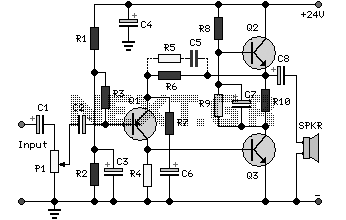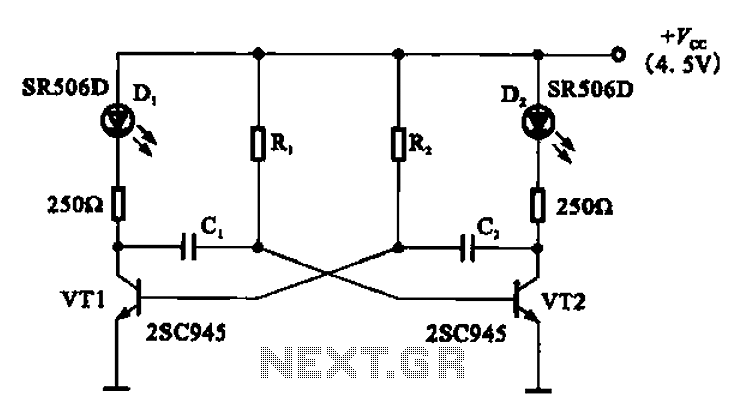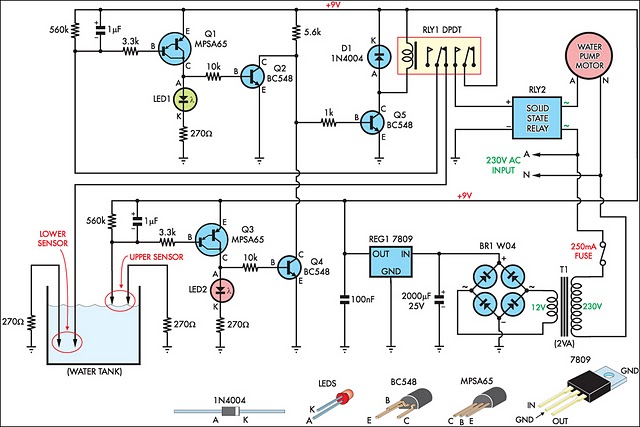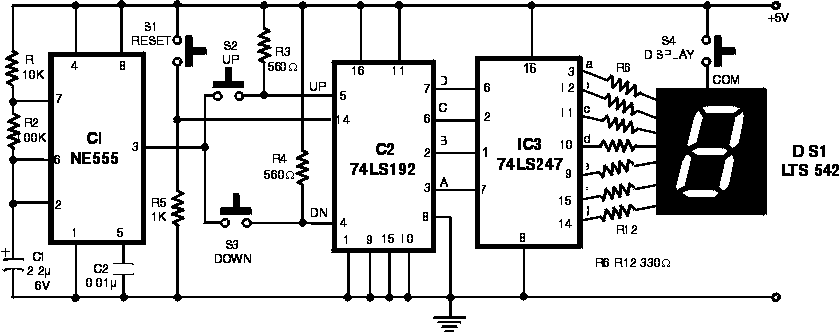
5 watt class a audio amplifier circuit

This solid-state push-pull single-ended Class A circuit is capable of providing sound quality comparable to that of valve amplifiers. It delivers an output power of 6.9W when measured across an 8 Ohm loudspeaker cabinet load, with reduced total harmonic distortion (THD), higher input sensitivity, and improved linearity.
This Class A amplifier circuit employs a push-pull configuration, utilizing complementary transistors to achieve efficient operation while maintaining sound fidelity. The design's single-ended nature allows for a simpler signal path, which is beneficial for audio applications where clarity and warmth are desired. The output stage is configured to drive an 8 Ohm load effectively, ensuring that the amplifier can deliver adequate power without distortion.
The circuit is designed to minimize THD, which is critical in audio applications to ensure that the output sound remains true to the original input signal. By using high-quality components and careful circuit layout, the amplifier achieves a low distortion rate, which is essential for high-fidelity sound reproduction.
Input sensitivity is an important specification for amplifiers, indicating how much input voltage is required to drive the amplifier to full output. This amplifier is designed with higher input sensitivity, making it compatible with a wider range of audio sources, from low-output devices to professional audio equipment.
Linearity is another key factor in amplifier design, referring to the ability of the amplifier to reproduce the input signal without introducing nonlinearities that can color the sound. This circuit's design prioritizes linearity, which contributes to its ability to produce a rich, detailed sound that is reminiscent of traditional valve amplifiers.
Overall, this solid-state push-pull single-ended Class A amplifier circuit represents a sophisticated blend of modern electronics and classic audio design principles, making it a suitable choice for audiophiles seeking high-quality sound reproduction.This solid-state push-pull single-ended Class A circuit is capable of providing a sound comparable to those valve amplifiers, delivering more output power (6.9W measured across a 8 Ohm loudspeaker cabinet load), less THD, higher input sensitivity and better linearity.. 🔗 External reference
This Class A amplifier circuit employs a push-pull configuration, utilizing complementary transistors to achieve efficient operation while maintaining sound fidelity. The design's single-ended nature allows for a simpler signal path, which is beneficial for audio applications where clarity and warmth are desired. The output stage is configured to drive an 8 Ohm load effectively, ensuring that the amplifier can deliver adequate power without distortion.
The circuit is designed to minimize THD, which is critical in audio applications to ensure that the output sound remains true to the original input signal. By using high-quality components and careful circuit layout, the amplifier achieves a low distortion rate, which is essential for high-fidelity sound reproduction.
Input sensitivity is an important specification for amplifiers, indicating how much input voltage is required to drive the amplifier to full output. This amplifier is designed with higher input sensitivity, making it compatible with a wider range of audio sources, from low-output devices to professional audio equipment.
Linearity is another key factor in amplifier design, referring to the ability of the amplifier to reproduce the input signal without introducing nonlinearities that can color the sound. This circuit's design prioritizes linearity, which contributes to its ability to produce a rich, detailed sound that is reminiscent of traditional valve amplifiers.
Overall, this solid-state push-pull single-ended Class A amplifier circuit represents a sophisticated blend of modern electronics and classic audio design principles, making it a suitable choice for audiophiles seeking high-quality sound reproduction.This solid-state push-pull single-ended Class A circuit is capable of providing a sound comparable to those valve amplifiers, delivering more output power (6.9W measured across a 8 Ohm loudspeaker cabinet load), less THD, higher input sensitivity and better linearity.. 🔗 External reference





